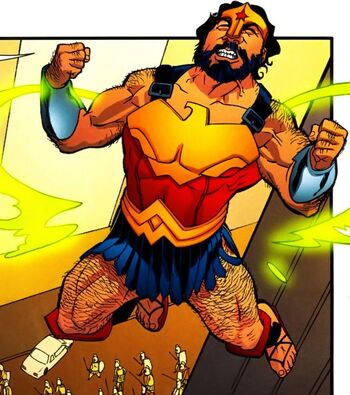_(Earth-94)_004.jpeg/revision/latest?cb=20141128022843) |
| Yep, he was Spidy. |
At the same time, when, where and how this trope is functional, particularly in regards to trends such as Dark Knights Metal’s framing rich, male and white Bruce Wayne as Wonder Woman (or rather, the Merciless). This was the question my previous post ended on. Having found myself reflecting on it that initial period of writing, I’ve come to something of a… further thought. Specifically regarding the Merciless and why it works. The Merciless isn’t the first transferring of Wonder Woman onto a male identity that DC has produced. Rather, in 1963, Superman battled a villain titled “Wonder Man” - one of the Superman Robot’s gone rogue. Later, during the One Year Later event, DC recast its version of Hercules as a “tongue-in-cheek” take on Wonder Man. Likewise, in 2005 DC introduced Earth 11, which featured gender-swapped versions of its characters, including a Wonder Man. While the robotic Wonder Man has about as much connection to Wonder Woman as the Marvel character of the same name, and Hercules never truly took on the role, the Earth 11 Wonder Man and the Merciless present an interesting case of parallel but not narrative.
 |
| Dane of Elysium, Wonder Man of Earth 11. |
Parallel I think is the optimal word there. The key as it were. In the same way that Spider-Gwen functions as a separate narrative to Spider-Man, or that Miles Morales began as a variant of the character that didn’t interfere with the main continuity, the Merciless and Wonder Man exist outside the mainstream, in the realm of multiverses and parallel earths - a clever way to make other narratives canon without interfering with the canon. So, unlike the backlashes both fan-based and from within companies, to changes to characters - such as that shown when Captain America was revealed as a Nazi, the concept or idea of a parallel continuity offers diversity without disruption. The problem is that while this is a safer route, it in many ways feels like a half-way-house. Part of the strategy and appeal of Riri Williams as Iron Man, or Jane Foster as Thor is that it is a disruption to the conventional story of powerful white men doing power white male… stuff. Multiverse characters such as the Merciless or Spider-Gwen are a safer option, but one that doesn’t have the same provocative effect.
The Curious Trend, Thinking it through again: Delivery is everything…
![The Curious Trend, Thinking it through again: Delivery is everything…]() Reviewed by Nicholas William Moll
on
Thursday, March 08, 2018
Rating:
Reviewed by Nicholas William Moll
on
Thursday, March 08, 2018
Rating:



